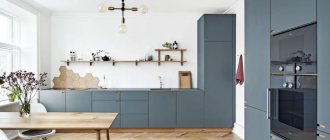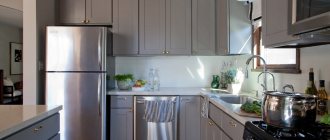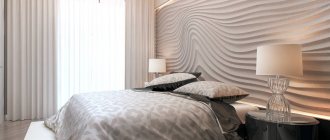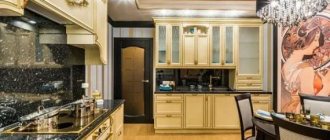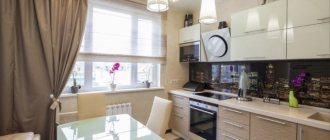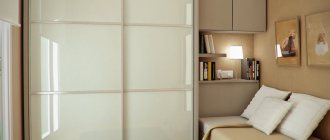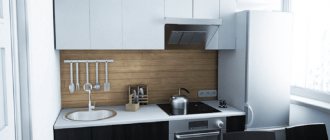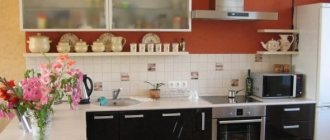Refusal of hanging drawers is in the trend of modern styles.
But let's be clear right away:
- From a design perspective, a kitchen without upper cabinets really looks cool. But..
- This is not about economy and practicality. The chances of screwing up so much that exploitation will infuriate you are great.
It is important to think not in pictures, but in ways of implementation.
Let's figure out what you really need to pay attention to in the photo and how to implement an open top, so as not to regret it later.
+ for many people, an empty wall is not as important as it is not to see it (I don’t like it either):
And then I will offer a super practical alternative.
Pros and cons of a kitchen without upper cabinets
Before deciding to introduce such an innovation, you need to weigh the pros and cons. Of course, not every housewife can decide to voluntarily give up half the space for storing dishes, dry foods, utensils and other items.
And this is the main disadvantage of a kitchen without wall cabinets. But is it really that bad?
First, about the benefits.
- The interior becomes lighter , more air appears, and the space is optically enlarged.
- The workspace does not need additional lighting, especially if you place it near a window using a window sill. There are many possibilities for planning.
- There is no risk of plaster and heavy cabinets collapsing (this can happen if the walls are not strong enough, for example, made of foam blocks, or if the furniture is poorly secured).
- Owners and guests will stop banging their heads on rickety furniture.
- Improved hygiene. A room with more light looks visually cleaner and fresher.
- You can decorate the apron up to the ceiling , hang open shelves and decorate them with original decorative elements, such as dishes, ceramics, live plants in pots, etc. A free wall gives room for creativity.
- All storage facilities are located in the lower cabinets . Arrange a full-fledged dining area with built-in drawers and shelves for utensils. This is great for short people who are tired of having to prop up a bench to reach things. Storage space becomes more accessible for people of all sizes and ages. However, some drawers, such as those containing sharp objects, may need to be kept away from children.
Furniture manufacturers recommend pantries or columnar cabinets, but sideboards have made a comeback as a modern trend.
These spacious designs look beautiful and can be a great place to store cutlery, crockery, coffee/tea sets, glassware, jam/juice jars and other useful items.
The disadvantages are as follows.
- It is difficult to think of other storage options to replace wall cabinets in small kitchens - they are a very practical option, so it is not recommended to abandon them in small apartments. And they add a lot of usable space by freeing up the floor. Studios are a different matter. The room is level with the kitchen allowing you to experiment with the interior.
- Open shelves used to decorate a free wall will quickly become dusty. Dust will also accumulate on objects placed on them. This will increase the time required for cleaning.
- The storage system will be located at the bottom , so you will often have to bend down to take out or put down an item.
- There is a huge free wall that needs to be decorated somehow. Of course, it will get dirty when using the stove, sink and will require additional cleaning.
If you consider the disadvantages, they can easily be turned into advantages, and this applies to rooms of any size.
Common mistakes
When installing a kitchen without upper cabinets, apartment owners are faced with errors that further reduce the functionality of the entire space and only worsen the ergonomics of the entire room. Most often, the following shortcomings are made when planning and installing this type of kitchen:
- Incorrect drying position. If you decide to choose a kitchen without upper modules, then it is not recommended to move the drying to the lower parts of the structure. Usually, for these purposes, the upper module is left above the sink, where there is no bottom or there is a small distance from the front to the bottom. Due to this design, air circulates, and moisture gradually disappears from washed dishes. If the drying is at the bottom, then the process does not work, and it is inconvenient to get dishes from below. It makes no sense to move the structure to another part of the room. It is best to purchase an additional dryer for drawers as an analogue.
- Installation of hood and outlet
A housewife who constantly prepares home-cooked food: cooks food, stews it, cooks something, simply cannot do without a range hood. Therefore, it will not be possible to get rid of this element along with the upper modules. Moreover, built-in hoods are most often also installed in upper tier cabinets. An analogue will be a box-type ceiling hood.
Placement of refrigerator, microwave and oven
Most often, apartment owners decide to simply use a linear layout for the kitchen without an upper tier. However, there are some subtleties here: if you place the refrigerator separately from the entire structure, then the atmosphere of minimalism is broken, since high technology will break the straight line in the room. In this case, experts recommend ordering built-in refrigerators of a smaller volume - among them there are budget options on the market.
In order for the refusal of the upper tier to make sense, it is necessary to maintain a minimalist style in the kitchen. The best solution would be a pencil case with a built-in refrigerator, which is installed all the way to the top. Visually, this design is similar to a mezzanine
The microwave and oven should not be left separately, since the overall atmosphere will be greatly affected in this case. It is recommended to install such equipment at hand level, since placing the equipment in the lower tier will cause additional inconvenience.
Lighting
If you need additional lighting in the kitchen, then it is not necessary to install it in the upper modules. Some apartment owners initially install it at the top of the apron, so they can fully appreciate the convenience of the technology. If you are getting rid of the upper tiers, then use this technique. Experts advise milling and attaching LEDs to the apron. Be sure to plan where and how you will place the power supply.
Sources
- https://wexy.ru/dizain-int/kuhnya-bez-verhnih-shkafov-7-nyuansov-dizajna-v-126-foto
- https://blog.gnezdo-mall.ru/kuhnya-bez-verhnih-shkafov-sovety-idei-foto/
- https://ars.ru/interer-dizayn-kuhni-bez-verhnih-navesnyh-shkafov/
- https://design-homes.ru/komnaty/kukhnya-i-stolovaya/kukhnya-bez-verkhnikh-shkafov
- https://cozynook.ru/kuhnya-bez-verhnih-shkafov/
- https://kitchen-eco.ru/mebel/garnitur/kuhnya-bez-verhnih-shkafov
- https://m-strana.ru/design/pravila-i-idei-obustroystva-kukhni-bez-verkhnikh-shkafov/
- https://salon.ru/article/kuhni-bez-verhnih-shkafov-foto-dizajn-osobennosti-aktualnye-trendy-48792
- https://kvartblog.ru/blog/dizajn-kuhni-bez-navesnyh-shkafov/
- https://minikuhonka.ru/%D0%BA%D1%83%D1%85%D0%BD%D1%8F-%D0%B1%D0%B5%D0%B7-%D0%B2%D0%B5 %D1%80%D1%85%D0%BD%D0%B8%D1%85-%D1%88%D0%BA%D0%B0%D1%84%D0%BE%D0%B2-%D1%81 %D0%BE%D0%B2%D0%B5%D1%82%D1%8B-%D0%B8-%D1%81%D0%B0%D0%BC%D1%8B/
How do you like the article?
What layout to choose for a kitchen without upper cabinets
There is no difference between a two-story and one-story kitchen. You have the same four options: corner, U-shaped, linear and island.
A corner kitchen is a convenient, functional and rational solution for space planning. The floor blocks installed in this case have an angular configuration. Floor and column cabinets can also be installed in corners along walls.
This way of arranging furniture easily creates a classic work triangle with a sink, stove and refrigerator. A corner cabinet is also ideal for kitchens of any size, especially small ones.
It is also a much cleaner option as it keeps dust and grime out of the upper cabinets.
Simple kitchens are also known as linear kitchens. All base cabinets are located on one wall. There is a refrigerator next to the countertop, and next to it is the cooktop and sink.
Linear layout is ideal for narrow kitchens. Without upper cabinets, the room will look larger and brighter.
If you are thinking about storage, then all the food and utensils can be placed in the lower section.
A U-shaped kitchen, where all the base cabinets are located along three walls, makes it easy to create a useful triangular work area.
It also has plenty of space to store utensils even if the upper cabinets are inaccessible. However, the U-shape can only be used in a medium to large sized kitchen. You shouldn't do this in a small room.
A large kitchen requires a special approach to its layout in order to make it beautiful and ergonomic.
A kitchen with an island is a layout where the main work surface is in the center of the room. An island can include a cooktop, a burner, an oven, a sink, a dishwasher—there are many possible configurations.
An island also allows you to free up wall cabinets without compromising the functionality of the kitchen. However, this type of layout is only suitable for spacious rooms with an area of at least 20 square meters. m.
When all surfaces in the kitchen are open, it is important to maintain perfect order and cleanliness.
Examples for different layouts
There are no gold standards for planning a kitchen without upper cabinets; it can be implemented both in long and narrow rooms and in spacious studios. The form of furniture arrangement should be chosen based on the parameters of the kitchen.
- The corner set will fit into almost any kitchen; with its help it is easy to organize the working triangle “stove-sink-refrigerator”.
- Linear placement is ideal for a narrow kitchen; single-level sections can be placed on one side or along two opposite sides. The absence of upper cabinets will help make the kitchen visually wider.
- Thanks to the U-shaped arrangement, the issue of storing numerous utensils is solved, but it can only be realized in an initially large space.
Corner
A corner kitchen does not take up much space and is also considered one of the most convenient options. All modules are located compactly, and the housewife does not need to spend a long time spinning between them to prepare dishes. Kitchen utensils are placed here so that they are always at hand. With a corner layout, there are options for arranging a refrigerator, washing machine and other household appliances. Check them out in the photos below.
No cabinets on one side
As mentioned at the very beginning, the absence of cabinets is not only a beautiful element of the kitchen, but also reduces the functionality of the entire space. Not everyone is ready to go for it. For such people, there is an option that will preserve the multifunctionality of the kitchen, as well as make it easier: only one side of the cabinets will be removed and a corner layout will be created.
In this case, some of the modules that are removed are replaced with shelves where jars and products are placed. This option is optimal for those who are used to storing a large number of utensils in the kitchen.
U-shaped
The option without upper cabinets is perfect where a U-shaped layout is used, since it is considered the most spacious option for arranging modules. In this case, designers use a large number of floor modules, which allow increasing space for storing food and utensils.
Linear
Linear layout is a universal option for apartments. However, here a lot depends on the area that is used in the layout: for small kitchens it is better to choose another option, since then the linear layout will lose its spaciousness. In other cases, it creates an excellent composition with a symmetrical arrangement of equipment and furniture.
In this option, designers place cabinets and install columns to obtain a large amount of storage space. They mainly use built-in appliances for cooking and storing food.
Double row or parallel
In this layout, in addition to the usual cabinets and lower modules, columns or tall cabinets are additionally installed. Sideboards and buffets will also look good here. With the help of additional furniture elements, it will be possible to obtain a large amount of free space - there will be more space than in a traditional two-tier set.
With an island
The island is a separate part of the headset, which is installed separately from the overall structure. The element is multifunctional: there are storage spaces in the countertop area, built-in appliances and other details of a modern kitchen. An island will pair well with tall, freestanding cabinets.
How to replace upper cabinets
To compensate for the lack of memory, you can use the following options:
- Wardrobe with columns. Suitable for large spaces. Ideal for cabinets opposite or on either side of kitchen cabinets. You can also build large household appliances into the cabinet, such as a washing machine, refrigerator, dishes, kitchen and food utensils.
- Install a sideboard, buffet, bookcase or closet to match the color and style of your kitchen. Suitable for small spaces. They do not require the creation of an entire wall. A big plus is the shelves, behind which you can beautifully arrange tableware, figurines, and favorite souvenirs to decorate and highlight the taste of the hostess.
- Open shelves. An ideal addition to any Provence style interior. Ideal for storing food and drink sets, kitchen utensils and spice jars. They are usually installed in conveniently located places, for example, above the sink, kitchen countertop or across the entire width of the wall in a chaotic manner.
- Rails. These are open shelves made of lighter material - metal. They can be used to place storage items, hang towels, handles, spatulas, kitchen gloves and accessories.
A corner cabinet model without extensions on one side is also available. Hanging cabinets provide storage without cluttering the space.
Main problems in practice
Home owners and interior designers face many challenges. These are the main disadvantages of kitchens without upper cabinets:
- Significantly reduced storage space. Utensils and utensils must be moved to other rooms and systems.
- Not all furniture and electrical appliances can be installed in such a room. Often, hanging units are used to store a gas water heater, utility systems, electrical wiring and packaging.
- A blank wall needs repair and additional decoration. In the case of new apartments this is not a problem, but in the case of used apartments it is a completely different matter. In such cases, large-scale renovations should be carried out using a good design plan.
Each case should be approached with special attention, exploring all possible options for layout, lighting and furniture organization.
Kitchen without upper cabinets in various styles
Classic style
When decorating a classic kitchen, designers recommend focusing on natural materials. Kitchen cabinets can be made from natural wood.
For a budget option, consider chipboard or MDF.
The walls are decorated with washable wallpaper with small patterns. The photo of a kitchen without cabinets in a classic style shows an interesting combination of wooden surfaces with the texture of natural stone and ceramics. The windows in the room are decorated with light curtains.
- The dining room should be well lit.
- Above the dining area is a pendant chandelier with crystal elements.
- For additional lighting, you can use wall lamps.
Brickwork
Great idea for a loft, Scandinavian interior.
Loft. Brick can be bright and rustic to add a rugged feel. Light brick finishes are best suited for a Scandinavian style kitchen.
Other styles in which brick finishing looks good are country, Provence, and shabby chic. In Provencal or vintage style, the bricks should be lighter, without sharp color contrasts.
High-tech and Minimalism
Modern style is good because it allows you to make non-standard decisions without regard to traditional methods of interior design. Designers advise using a minimum amount of furniture in this interior. There is simply no need to buy upper cabinets.
The room remains light, airy and minimalist. The finishing materials most often used are plastic boards, chipboard, metal, porcelain stoneware and artificial stone.
Modern
A room decorated in this style is a work of art. It is characterized by high gloss, regular and strict geometry, the use of metal, glass and even plastic.
The lighting is accentuated: there should be a large chandelier and several single lamps, sometimes with LEDs. There are no color requirements - you can even use black.
Country
A pleasant rural style that will give a feeling of nature even to people living in a metropolis. Provence is an integral part of:
- natural materials;
- rustic and simple finishes;
- calm color scheme.
In country style, it is easy to do without extensions, replacing them with shelves made of thick wooden boards.
Art Deco
Luxurious style for those who love classics. Most often used in large apartments and country houses, where the kitchen is combined with a dining room.
Only the most expensive materials are used: mahogany, silk, leather, crystal. There should be stucco and patterns on the walls.
If you remove the top set, then in its place there should be only paintings - this style does not like open shelves.
A kitchen without wall cabinets is an excellent solution that will give the room originality and lightness. It can be integrated into any interior. Experiment - this is the only way to get a kitchen that will delight you for many years!
Loft style
A kitchen without cabinets is an ideal solution for a loft style. Metal shelves on the walls are a great alternative.
The upper cabinets will not block large windows, so the room will be filled with light.
The interior design uses brick, concrete, natural wood, metal and glass.
Provence style
Photos of kitchens without wall cabinets in the Provence style reflect the beauty of the rustic style. The walls are usually painted in milky shades.
Flowers in ceramic vases are placed throughout the room, and the windows are decorated with chiffon curtains.
- For this soft, romantic style, the kitchen is beautifully designed without cabinets.
- There are many shelves to store interesting decorations and kitchen utensils.
- Wardrobes, chests and other pieces of furniture that cause depression can also be used as storage.
Futurism
An unusual design move, intended for the young and active. Its basis is white and metal surfaces, unusual furniture and bright accents.
Any, even the most daring design solutions are possible here, so the rejection of the top set in this case will not surprise anyone.
Recommendations for small kitchens
When choosing furniture for a “Khrushchev” building, you need to take a closer look at the single-level set. Several open shelves will allow you to place all the necessary utensils and will not create a feeling of clutter.
When creating an interior for a kitchen of modest dimensions, designers advise:
- give preference to light colors (milky, gray, blue);
- refuse massive furniture;
- leave one height-adjustable chandelier on the ceiling;
- use styles - Provence, country, minimalism, modern.
- open walls, decorate with mosaics, imaginary bricks, glass or laminated chipboard panels.
The basic principle of decorating small rooms is the need to rationally use the available areas.
Wall Design Ideas Without Upper Cabinets
An empty wall in the kitchen without upper cabinets will be conspicuous one way or another, so you need to decide whether to accentuate this area or “calm” it?
Color can be achieved using paints or materials. For example, a brick or chalk wall will brighten up the interior. A bright apron made of unusual tiles, original wallpaper or a painting in colorful colors will also be an excellent accent.
The photo shows a kitchen without wall cabinets with a brick wall.
An alternative to brightness is calm tones and standard designs; objects on the shelves will attract attention.
Why choose a single-tier kitchen
Often, guided by personal preferences, they get rid of the stereotype of the classical model and create an individual, unique space. The interior is designed to be a reflection of the inner world of its owner. The originality of the kitchen model without upper cabinets is high. A radically different design, different from the usual one, brings lightness and openness.
A single-tier kitchen, which allows you to fit a sufficient number of necessary things without clutter, is quite acceptable. Such diversity becomes a fresh solution.
Indeed, why burden the work area with unnecessary furniture. The main thing is that the kitchen meets functional needs, is spacious enough, and ergonomic. The absence of unnecessary objects near work surfaces will be an excellent indicator.
For some types of kitchens, such an organizational model is simply necessary. It will smooth out the load and create a feeling of spaciousness in small rooms. Here it is important to achieve the desired effect; creating additional clutter is strictly contraindicated. An elongated kitchen will become visually shorter due to the absence of upper kitchen cabinets.
When there is little natural light, avoiding wall cabinets, combined with wall decoration in light colors, will add light and hide the gloom. Some interior styles are against unnecessary details, so a set without upper modules is perfect.
Design of a living room combined with a kitchen
The beautiful kitchen design is visible from the living room, allowing you to appreciate the aesthetics and atmosphere. The walls in traditional house designs don't seem as compact. You can easily move around a large room without bumping into furniture or people. This style of kitchen has many advantages.
The open kitchen is appreciated and loved by interior designers and home remodelers all over the world. When there is no wall between the kitchen and dining room blocking your line of sight, you have plenty of space to do much more. A kitchen in this style is an excellent solution for small spaces that are too cramped by a wall.
It is much more convenient than the traditional style. You can put more tables and chairs where there will be a wall, or leave it open during family gatherings to prevent people from bumping into each other. Thus, this type of connected kitchen makes it easier for people to interact with each other, which is why it is preferred by many people. Plus, it allows you to get more natural sunlight, which will inevitably brighten up the room and improve the ambience!
Yes, people all over the world are praising this kitchen design as it has endless benefits. But there are still factors to consider if you are thinking about renovating your kitchen and adopting the open kitchen concept. When the barrier (wall) is removed, the open space will leave room for more noise. There are no more walls to disrupt sound and prevent it from moving from room to room. Sound will only be a problem during parties and gatherings.
Keeping your space clean is much more important now than when you have a traditional style kitchen. Therefore, the more this style develops, the more people will work on how to improve minor flaws. There are many solutions that can be found, which is why interior designers and kitchen remodelers love this design.
The layout of an open kitchen can vary, such as a long space with a kitchen, dining and living area, or it can be a more square or L-shaped layout. The main thing is that the space is open. Typically the dining room is located between the kitchen and living room.
Choosing material for a kitchen without upper cabinets
An issue that you should decide fairly quickly to make your search for the perfect shelf easier is the material from which it will be made. Wood is considered a classic choice as it is used in the kitchen. It looks great in Provence style.
Now you can approach the choice of material with complete imagination, because designers are so original that they create shelves from...:
- fake diamond,
- plastic,
- glass
- and even metal.
Wood is universal, which is why it is most often chosen. Wooden shelves are durable and practical, they are easy to make with your own hands and repair.
Glass
Glass models are just as practical as glass ones and look very cool and lightweight. Glass allows light to pass through and is easy to keep clean. The main thing is to use only hardened material. The disadvantage is that it is quite difficult to make such a shelf with your own hands, and special connectors with:
- rubber gasket;
- rubber gasket; - clamping bolts.
This will fix the glass as securely as possible and prevent it from accidentally falling out.
Plastic
Plastic is a cheap and easy-to-clean material, but should not be placed near a stove, especially a gas stove. Plastic shelves themselves are not the most durable, so this material is rarely used in the kitchen, although it is easy to work with even with your own hands. You can place on them:
- small vases and figurines;
- Photo frames;
- light meals;
- spices in jars.
Shelves of fancy shapes are not uncommon and help to emphasize the originality of the interior.
Metal
Originality is a characteristic feature of metal shelving. It is better to choose appliances made of stainless steel or other metals that do not rust, otherwise they will not survive in the microclimate of your kitchen. It is difficult to work with metal at home, so you should look for ready-made options. They come in a variety of colors, such as chrome and gold plated.
This material has many advantages:
- reliability - even with a small thickness they can withstand significant weight (if installed correctly);
- durability;
- beauty;
- easy to clean.
The most popular option for a metal rack is a mesh basket for storing and drying freshly washed dishes.
Stone
Real stone weighs a lot and requires special care, so it is rarely used. Artificial stone, on the other hand, is much lighter and more pliable, so it can be installed almost anywhere. The most common place for such shelves is
- above the fireplace - real or artificial;
- on a tabletop made of the same material;
- on the side columns.
Artificial stone is environmentally friendly, durable and looks great in almost any design.
Other modern materials
Sometimes you'll find shelves that look like they were cut into the wall, like the one in the photo above. In fact, you don't need to saw anything - such a structure is very easy to make from plasterboard supported by metal profiles. The most important thing is to finish the job with putty to hide the seams. Then you can be creative and decorate it however you like, but usually it is painted to match the color of the wall.
Shelves can also be made of chipboard or MDF. Their feature is a hidden fastening, which creates the impression that the shelf is simply floating in the air. However, this has a drawback - such a mount is not strong enough, so it is better not to place heavy objects on such a coating.
The most important thing when choosing a shelf is to find a texture that will harmonize with the overall interior of the kitchen. For example, glossy steel shelves are only suitable for modern styles such as fusion, minimalism and hi-tech.
Selection of style
Many people believe that a kitchen without an upper tier of wall cabinets and modern style (or Provence) are incompatible concepts. However, there are ready-made design options. The designs can be seen in the photo, which will help you choose the appropriate style.
Provence
The interior, designed in this style, looks very romantic and is most often decorated in Khrushchev buildings. A Provence kitchen without wall cabinets will remind you of a bright country life. You can choose a design from real photos in the selection below.
This is interesting
!
Most often, softened shades of wheat, turquoise, mustard, lavender, and olives are used for such an interior.
Furniture fittings must be made from natural materials. A characteristic feature of Provence is the imitation of antiquity. Another feature of this style is the use of many wooden shelves.
Attributes typical of a Provençal interior: fireplace hood, carved wooden shelves, vases with flowers, light pink kitchen furniture, wood flooring.
Arrangement of a kitchen without upper cabinets
Designing a kitchen without upper cabinets requires good planning and space. This is worth remembering when choosing furniture. The most common countertop depth is 60-62 cm. This is dictated by the width of the MDF boards from which countertops are usually made, as well as the size of the appliances.
A deeper worktop also means longer drawers and therefore more storage space (under a 70cm deep worktop you can install drawers on 65cm rather than 55cm runners).
However, keep in mind that any non-standard kitchen design solution costs more. No one needs to be convinced that drawers and drawers are more convenient than shelves. When you pull out a drawer, you can see everything in it, and best of all, you don't have to bend over.
Placing an oven or microwave on your kitchen counter also has obvious benefits. Not only is it easier for you to control the cooking process, but you also don't have to lift heavy cookware.
Headset configuration
A kitchen “without a top” provides no less (or even more) scope for configuration than a traditional one:
- you can arrange the set linearly, U-shaped, L-shaped, or opt for a corner kitchen without upper cabinets;
- you can place floor cabinets in two parallel rows (relevant for zoning or for small, narrow kitchen trailers);
- you can provide a kitchen island;
- place the set by the window;
- add a bar counter - and the kitchen interior without upper cabinets will receive a new design;
- use open shelves, rails, and various hanging organizers as wall storage;
- complement with column cabinets with built-in appliances.
How to organize storage?
If you think ahead about where you'll store dishes, spices, and all those things that most homeowners are used to storing in upper cabinets, you won't have to sacrifice convenience and functionality for a trendy design. Here's how to replace conventional storage.
Fit everything in the lower cabinets
You may think that you don't need that many upper cabinets, but that's not true. How can you determine this? Here are some signs:
- Most of the shelves at the top are empty because you don't need a lot of storage space for your small family. And you don't have all the nooks and crannies crammed into the lower cabinets.
- You don't see a problem in bending down more often to get the necessary kitchen utensils.
- You are open to new design ideas and would love to swap your regular dish drainer for an unusual one built into the bottom drawer.
If you answered “yes” to at least one of the above statements, it’s time to think about what section you will allocate for plates, cups, where you will put pots and pans, and where there will be a new place to store cereals. Here are some suggestions on how you can fit it all into your base cabinets.
Pots and pans storage ideas
Drying in the bottom drawer
Store in pencil cases, cupboards, on racks
One tall wardrobe like this can replace the entire top row of a medium-sized wardrobe.
Even in a small kitchen you can find room for one such tall cabinet, and in some cases you can even install two.
3. Use the space under the sink wisely
Even with a deep sink, the space underneath can be put to good use. Use hooks for hanging gloves and brushes, storage containers, drawers. Here are some ideas on how you can use this area.
How to distribute kitchen appliances
To prevent the removal of the upper part of the kitchen unit from leading to a lack of storage space, furniture pieces are provided for the kitchen in which you can place household appliances and large utensils.
Storage space can be organized by:
- open shelving;
- high units;
- Built-in modular shelving.
They can be used to store kitchen utensils, spices, bottles, jars and containers for bulk products. The best place to install devices is at the base of a cabinet consisting of several shelves. This makes the shelves less cluttered and the interior more harmonious and rational.
Shelves for white equipment, such as bread makers, deep fryers, multicookers, coffee grinders, etc., should be quite massive and very durable. A large cabinet will accommodate not only all kinds of dishes, but also large household appliances, such as a microwave oven.
Warning.
The stove should be at a distance of 1.2-2 m from the sink, and the refrigerator - 1.2-2.5 m.
Alternative: partial elimination of overhead storage
Do you like the idea of partially relieving the wall of wall cabinets, but don’t want to sacrifice storage and ease of use? There is an alternative option - a “golden mean” for doubters: a partial rejection of the upper shelves of the set.
Leave one or two wall cabinets (for example, having resolved the issue with the hood and dish dryer), and you can safely discard the rest. This way the kitchen will receive the necessary “air”, but at the same time remain functional and comfortable.
Lighting organization
Lighting in kitchens is usually controlled by a central light fixture. This often causes problems in rooms where you have to cook with your back to the light. If there are no wall cabinets, good all-round lighting can be provided by installing wall lamps.
Lighting options:
- Classic lamps - they are attached to walls freed from cabinets;
- LED strips - these are attached to the wall or to the underside of shelves if you need it;
- installation of movable structures, if we need reverse lighting - we can direct the light to the sink, stove or countertop;
- traditional ceiling chandeliers - suspended or built into a suspended ceiling.
In a kitchen without upper cabinets, both pendant and spotlights along the walls will look great.
Optimal color scheme for a kitchen without a top
First of all, pay attention to the style of the interior, and only then decide on the choice of a suitable shade. For example, headset modules without upper structures should be chosen taking into account the shade of the room's cladding. According to designers, the most fashionable colors in the palette are:
- bright with notes of tenderness (lime, green, ash brown);
- enchanting (with paintings on the walls and façade, red, orange, pink, lilac);
- peaceful (calm pastel colors: beige, gray, white extremely rarely);
- airy (blue, turquoise, blue with whitish stripes).
Other design options are available. At the same time, cabinets should not look pretentious and rude against the general background of the room. The design of a kitchen without upper cabinets will turn out to be original if you try to alternate different shades of the lower set when arranging.
On a note! If the kitchen has built-in household appliances located on the lower tier, its doors can be highlighted with a different, similar shade. This option is especially attractive if the equipment is located on both sides of the modules.
